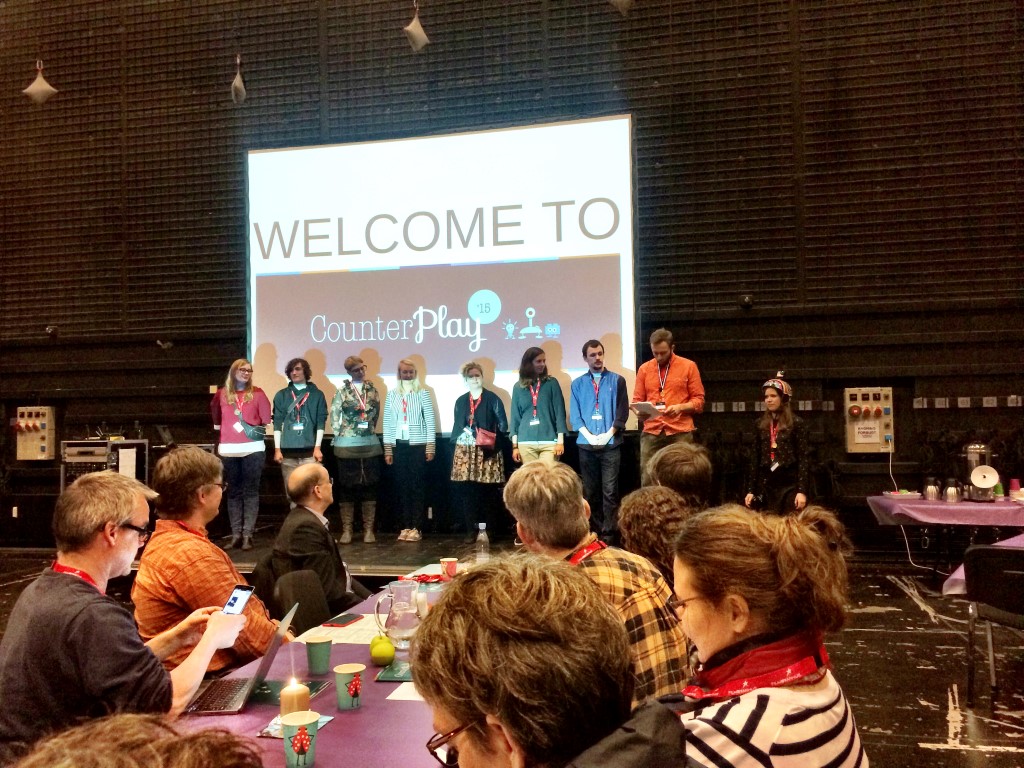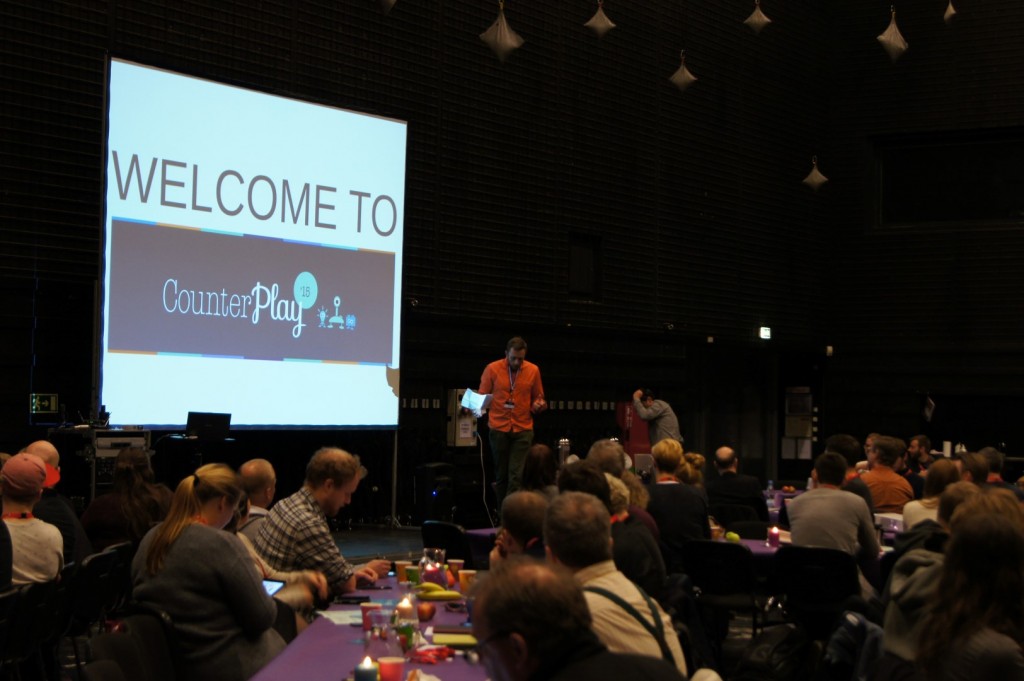With the second edition of CounterPlay over, we’re working on evaluation and documentation…and slowly preparing for CounterPlay ’16.
I thought I would share some thoughts from behind the (already fairly transparent) scenes, so this post is my personal reflections on my work with and experiences from the festival.
Leading up to the festival, I had been equal parts busy and terrified. So many things could go wrong, so many people could end up being disappointed. I had expected things to be easier than the first time, but it was the exact opposite. Almost every single thing was harder. Maybe the newsworthiness made the first time more smooth, maybe more was at stake this time. Part of it certainly had to do with moving to a new venue.
When it was finally time to welcome all the wonderful participants, well, I was still terribly nervous. Almost 200 lovely people were seated, ready to dedicate two days of their busy lives to engage with a topic so incredibly important to me.
We want to connect domains, that are usually disconnected. We want to bring people together, who would probably not otherwise meet. These days, it’s easier than ever to stay in our own circles or “bubbles”, as it’s often called. I really, truly believe that for better things to happen in this weird, messy world, we need to explore things that matter – together. We need to accept that no single homogenous group can do much by themselves.
Play can be utterly transformative, it can change the way we interact with each other and the way we see the world around us. When we’re playing, we’re in another state of mind. Play allows us to see things in a different light, it can create a kind of “friction” between us and the world.
I always wanted you to use the festival to create something, that is important to you. I can’t stress this enough – please steal the festival! Please use it as a framework, a lens, a stage. If you feel like making something happen during the festival, just go ahead.
And then it all began.
Walking around the venue, keeping an eye on the sessions & on the #CounterPlay15 stream, it would seem things are going well. Phew.
— Mathias Poulsen (@mathiaspoulsen) April 9, 2015
My gut feeling says I should be satisfied. I’m calm again, and I’m happy with how it went. People smiled a lot and many lovely participants said very nice things.
What I loved
More than anything, I’m impressed with the atmosphere (again). Early on, I got the impression that people felt safe, relaxed, eager to participate and play. It’s the most important part of CounterPlay and what must be preserved at all costs. It’s illustrated beautifully by this that happened at the end of Elaine Rumboll’s wonderful keynote:
https://vine.co/v/eB2b5KB2Tld
While we had several hiccups, things that didn’t go according to plan and small surprises, I think most sessions went more or less like they were supposed to. This was only partly due to our planning, and mostly due to the amazing flexibility of the many wonderful contributors and incredibly helpful participants – so thank you, all of you!
CounterPlay is made up of so many different components, and this year it was also spread over a fairly big area, but it seemed like people were moving around a lot, exploring the different areas and tracks.
After the main part of the festival, we hosted a smaller “academic workshop”, and while we were only around 15 people, it was a great opportunity to dwell on the impressions from the festival (thank you, Stine & Camilla for the effort you put into that!).
People really embraced Twitter during the festival, and lots of discussions took place at #CounterPlay15 (all collected here). Let’s keep up that conversation (and do remember the Facebook group as well).
Oh, and the food. Man, was I impressed by those people (Mefisto & Gourmiddag, if you’re curious). If we can, we’ll make sure to use them again next year, I promise.
Things to work on
While I’m generally happy, I also see lots of things to tweak and change (and I’m more than happy to hear from you in this regard).
The “academic workshop” was a wonderful experience, partly because it was separated from the main part of the festival, but it also meant most people missed out. It was basically just a space to reflect upon and discuss some of the central topics at a slower pace. I think we’ll keep the workshop as a stand-alone activity, but we’ll also to figure out how to embed that “space” into the festival, maybe like a “World Café“, as suggested by Moire O’Reilly:
@mathiaspoulsen agreed | a #worldcafe process that is very powerful and should be built into CounterPlay 2016
— Moira O'Reilly (@memoir88) April 15, 2015
@mathiaspoulsen check out the process as a guideline | read The World Cafe : Shaping Our Futures Through Conversations That Matter
— Moira O'Reilly (@memoir88) April 15, 2015
The Play Space didn’t work out exactly as I had hoped. It wasn’t the central hub like last year; it wasn’t the rug that tied the room together. This can, to some extent, be explained by the venue combined with a tight schedule. Having to go all the way to the 6th floor, while things were going on elsewhere probably caused many people to miss it altogether. We’ll also need to work with the diversity of the content, so it covers a broader spectrum of playful activities.
I know some people ended up at talks/workshops that weren’t what they expected. We can probably never avoid this, but we’ll have to make the program more transparent next year. We can improve the descriptions, maybe develop a model to ensure all descriptions answer some basic questions.
Finally, I always intended to do more with CounterPlay than “just” the festival, and we’re currently contemplating how to do that. How do we take topics, issues, questions and debates from the festival and investigate them elsewhere – in schools, libraries, museums, private companies and so on. Can we facilitate playful experiments that link the festival to everyday practice? Initiatives that would themselves create value locally, but could also help develop the festival.
Stay tuned, stay in touch, help us shape the festival and let’s stay playful together.


Leave a Reply